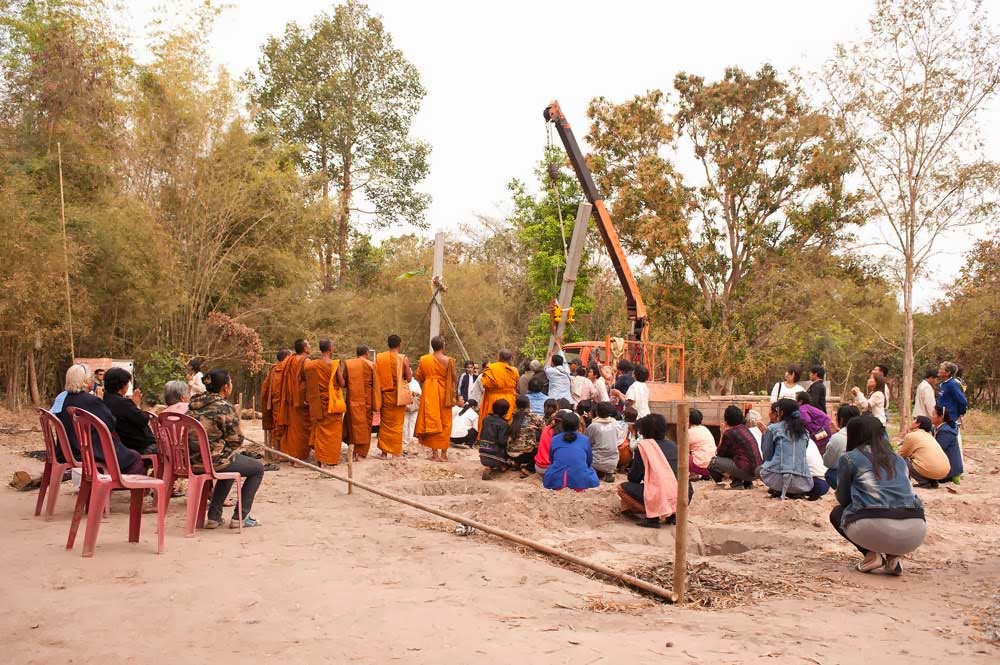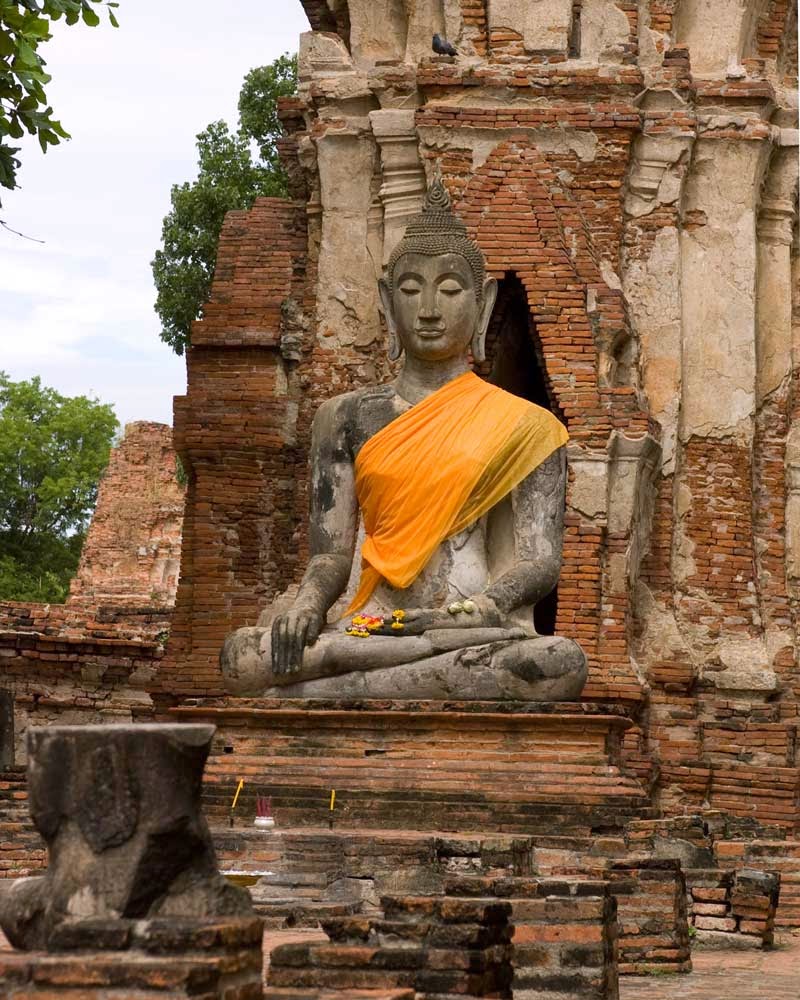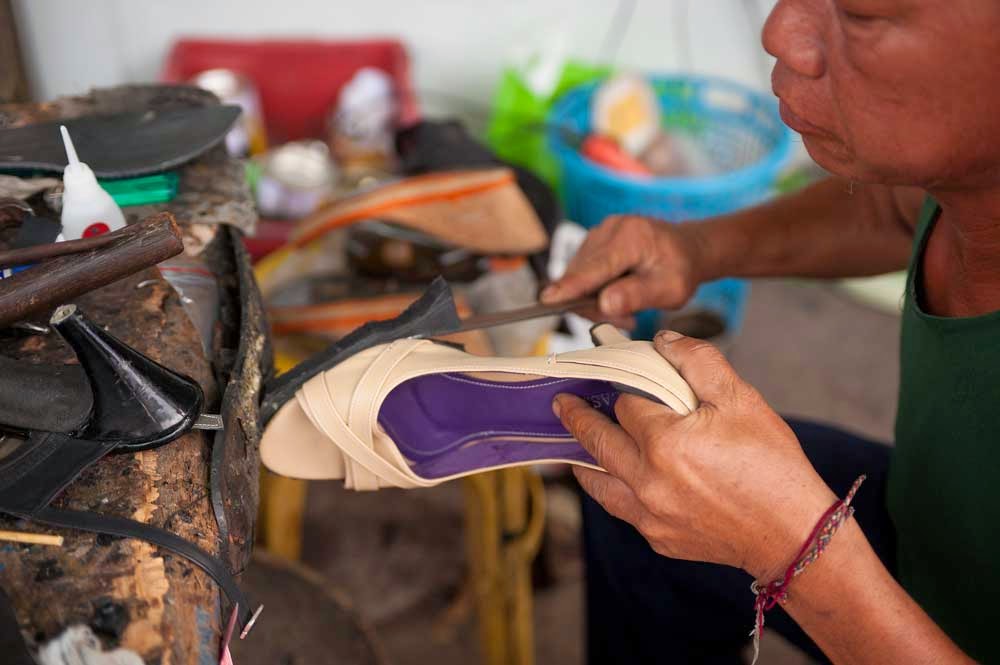 |
| Sand Is For Concrete and It is for Playing Too |
They say that time waits for no man. Two days ago I found that time has moved on and left me behind - behind in writing a blog entry about building a sala for Luang Paw Pohm Likit, the Forest Monk.
While others may ponder the answer to the question of what came first the chicken or the egg, I am often contemplating the question of what should come first - a blog entry or more photographs. I had an idea to write a blog entry about the sala, worship hall, for the Forest Monk. As it turned out to be I have become very busy with taking photographs of two funerals, elementary school field day, fabric weaving, and two trips to Lao so the blog did not get written.
 |
| Current Sala for Wat In Baan Mat |
A Sala is an open pavilion that shelters people from the sun and rain. At a Wat, the Sala is where merit making rituals are performed. The offering of food to the Monks takes place in the sala as well as funeral rituals.
The current sala for the Wat outside of Baan Mat is very primitive. It consists of a bare concrete slab that is sheltered by a thatched roof that is supported by 3 to 4 inch diameter tree columns and a lashed bamboo roofing sub-structure. The thatched roof apparently was not waterproof so there is now a large plastic advertising banner draped and lashed over the thatched panels to improve the weatherproofing. At one end of the sala there is a raised bare concrete platform the width of the pavilion where the Monk sits and off to his right on the raised area is a shrine.
 |
| Far End of Current Sala |
The end of the pavilion that is raised has some polyethylene nursery cloth (sun and bird protection) attached to the pavilion columns to provide additional weather protection. Apparently the weather protection was not completely adequate because a sloping sheet of recycled corrugated metal roofing has been suspended over the shrine to deflect any rain from it and on the outside four large waterproof election signs have been attached to bamboo poles to serve as a quasi wall beyond the nursery cloth.
 |
| Excavation for Footing and Materials to Mix Concrete |
At the end of January the construction of a new sala was started. Holes for the columns of the structure had been excavated and the workers were in the process of pouring the footings for the columns. I had spent my working career involved in the construction of heavy construction facilities as well as a few commercial facilities around the world so the building of a new sala piqued my curiosity and revived memories of times gone by - visions of projects past, present, and yet to come?
There is no worry about frost and subsequent frost heaving for a foundation here is Isaan. Earthquakes are also not a concern in this region. High winds are also not an issue here. With the absence of these considerations the excavations for the footings were shallow and dug by hand.
Reinforcing steel for the footers utilized smooth small diameter bars rather than the larger diameter deformed concrete reinforcing steel (rebar) that I am accustomed to. The workers only used one mat of reinforcement per footing rather than the two mats that I had experienced. It appears to me that the reinforcement add to the sala's footings contributes mainly to distribution of the heat during curing of the concrete than to increasing the load bearing capacity of the footing.

After the footing had been poured and cured, the workers placed a section of reinforced concrete pipe on the footing in the excavation - putting a round concrete ring in a square hole - it can be done and quite easily if you pay attention to dimensions. I have no idea what the purpose of adding the concrete pipe to the column foundation served. Through Duang, I asked the "Big Boss" why they were adding the concrete pipe when they could save labor and money by just pouring the foundation against the exposed earth? I didn't get an answer and Duang told me "Thailand not like America" which translates into "things are different" and "don't ask any more questions".
To control dimensions and orientations, the workers had set up batter boards outside of excavations and outline of the new structure. This being Thailand, the batter boards were bamboo poles rather than finished lumber. Strings were pulled from nails driven into the bamboo holes to establish center-lines or offsets as required. Elevations were established using a very simple device - a water level. A water level is a flexible transparent hose filled with water. The height of one end of the tube is adjusted so that water level at one end of the open ended tube is adjusted to match a predetermined elevation. The water level at the other end of the tube will match that predetermined elevation. By repeating the process many items can be set at the same elevation.
Through the use of tubing, string, nails, and bamboo poles the workers had a system to ensure that the columns would be set properly for a square and flat building without the use of sophisticated, delicate and expensive surveying equipment. The workers were building the sala the old fashioned way - using very old methods.
On Wednesday we arrived at the Wat at 8:30 A.M. The morning offering of food to Luang Paw Pohm Likit typically starts around 10:00 A.M. but prior to offering food on Wednesday there was to be a special ritual of setting the first two columns of the new sala. It had been determined by the Monks that the opportune time to commence setting the columns was "09:00 12 February 2557 For this special occasion, there were 8 Monks besides Luang Paw Pohm Likit. I recognized some of the Monks from the Buddhist school and Wat in a nearby village where we had attended a funeral ritual earlier this month.
There were also more lay people than is typical on any given morning. Building of a sala earns merit for the participants - extra incentive no doubt to the adage "Build it and they will come"
 |
Woman Places Offerings of Coins and Leaves In Excavation
|
 |
| Offerings to the Spirits - Coins and Leaves (the fresh leaves inside the excavation) |
As formal preparations were made for the ritual, people at their own pace went from excavation to excavation making offerings. The offerings were coins and fresh leaves. This has nothing to do with the official practice of Buddhism but as I have written several times before "there are the ways things are supposed to be and the way that they are". Many aspects of Buddhism as practiced here in Isaan are actually remnants of the previous dominant religions in the area - Hinduism and even further back - Animism.
The offerings are made to the spirits - the spirits of the land, the spirits of the garden, and the spirits of the home. The offerings are also made in the name of the spirits, the spirits of departed family members, so that they too may earn merit from this special occasion. The coins are offered to bring good luck and good fortune. The leaves are offered as reminders of the impermanence of this life. There was also a plate of food offered to feed the spirits.
I was somewhat surprised to see that most of the excavations did not have the section of reinforced concrete pipe placed inside of them. It is possible that no more sections had been placed since my observations of two weeks ago. There was also no longer a stock pile of reinforced concrete pipe laying around the site. Perhaps they actually listened?
While people were making their individual offerings, others were busy preparing offering that would be placed on the actual columns to be set.
 |
| Lay People Prepare Offerings of Banana Stalk and Sugar Cane |
The offerings to be attached to the columns were different. The first column offering was a woven vase shaped bamboo basket containing a banana tree stalk and a pumalai (floral garland) of fresh chrysanthemums bound together with saii sin (white cotton string). The second offering was also a woven bamboo basket but shaped like the baskets used to store trapped fish in the water when fishing. This basket had a stalk of sugar cane and a pumalai of the yellow chrysanthemums - all bound with saii sin.
 |
| Hauling the Selected Columns To Location for Setting |
After the people had finished putting the offerings together, one of the Monks came over, took the offers, and brought them to where the two selected columns were laying on the ground with all the other columns. The columns were lifted by a truck crane and placed on the back along with the offerings and driven the very short distance to where they would be set. The columns were off loaded and placed on the ground along side their respective foundations. Under the supervision of another, more senior, Monk the offerings were placed and secured around each column with a thick saii sin.
As the Monks chanted and the people either knelt or assisted the crane, the columns were lifted and set one after the other.
 |
| Monks Connected to a Column By Saii Sin |
 |
| Rigging the Second Column for Lift |
 |
| Setting the Second Column |
In writing this blog today I noticed that the first column was not actually set until around 09:15. I questioned Duang about this and she reassured me that it was OK. The best time to start was 09:00 but that it was OK to set at 09:15 - just not 10:00 or 11:00. Thailand is known as a land of tolerance and I guess that means tolerance in scheduling of work activities even of a religious nature. It is part of the charm that I find so interesting and fascinating here.
The Forest Monk, Luang Paw Pohm Likit, did not supervise the setting of the columns or lead the ritual. He wandered about the area and acted as a host. According to Duang, you don't preside over the building of your own temple. It makes sense now that I think of it. To preside over and lead the ritual would be to demonstrate want and desire which Buddhists strive to free themselves of. With the other Monks carrying the religious load, Luang Paw Pohm Likit is freed to only accept the offering from the people of the new sala.
As soon as a column was set, workers scrambled to brace it with long bamboo poles. The four bamboo poles were attached to the column with pre-cut double twisted iron wire. The bamboo braces kept the columns from falling over in the wind. It was at this point that I became concerned. No I was not concerned about the safety aspects of the work that they were doing or their lack of personal protective equipment. I was concerned about the location of the columns. The batter boards had been dismantled before setting the columns. There were no scribe marks on the footings to indicate the required center lines for each column. No one was taking any measurements or sightings either by eye or instrument to ensure the proper location of the columns to each other or to the overall planned structure. Actually there were no plans - blueprints or plans of any color.
After several inquires and expressions of my concern, through Duang as my interpreter and my pantomime, I kept getting the same answer "No problem, set all columns, then Big Boss come and take care, make everything 100%" Hmm OK but ... I had forgotten "Thailand not like America"
After the columns had been set, the people and Monks returned to the adjacent existing sala to have the daily merit making ritual of offering food to the Monks. There was a vast quantity and variety of food for the day. I joined the gathering, after the Monks had selected their food, to have my second of three meals for the day - a delicious bowl Ratna (Lat Na) - Thai thick and wide noodles in gravy with mushrooms, and seafood sausage. When it was time for the Monks to leave, the senior Monk gave me two bottles of Coke and one water that he had been given but was not going to drink. It came in very handy for the remainder of our day.
While people were making merit and eating, the workers were moving the remaining columns for the sala the old fashion way - bamboo poles and plenty of people
 |
| Transporting Pre-Cast Column to Its Foundation |
As we prepared to leave, we offered a ride from the Wat into Baan Mat to three elderly women who had walked out for the rituals. They were happy to take the ride for the road is now very dusty and the temperature was in the low 90s F. As they placed their bags and baskets in the pickup bed, I pointed to the pickup bed and said "10 baht" and then pointed to the back seat of the cab and said "20 baht" - they knew that I was joking and started laughing. Every one got in the back seat and told me "Thank you, good luck to you, Money come soon to you" After Duang translated I turned my head around, looked back at them and said as I pointed to each one "Yes I know money come soon, 20 baht, 20 baht, 20 baht ... 60 baht total!" Duang translated but it wasn't really necessary ... they understood and were laughing their heads off.
We dropped them off in the village no more money than I had started with but so much richer for the experience. The people here have a wonderful and very large sense of humor which makes living here as a foreigner who can not speak the languages, Thai and Lao, so much easier because humor is communication that everyone understands and appreciates.
Today was a special religious day. Duang went to the Wat to observe the holiday. Luang Paw Pohm Likit and several of the others asked where I was and why I had not come - the Big Boss was on site making everything 100% for the columns. They were laughing that I had made a big deal about the other day and then when it was to be done, didn't show up. They did say that I needed to come out tomorrow morning to see.
Yes, humor ... you have to be able to take as much as you give to truly appreciate it ... and to be appreciated.

























































